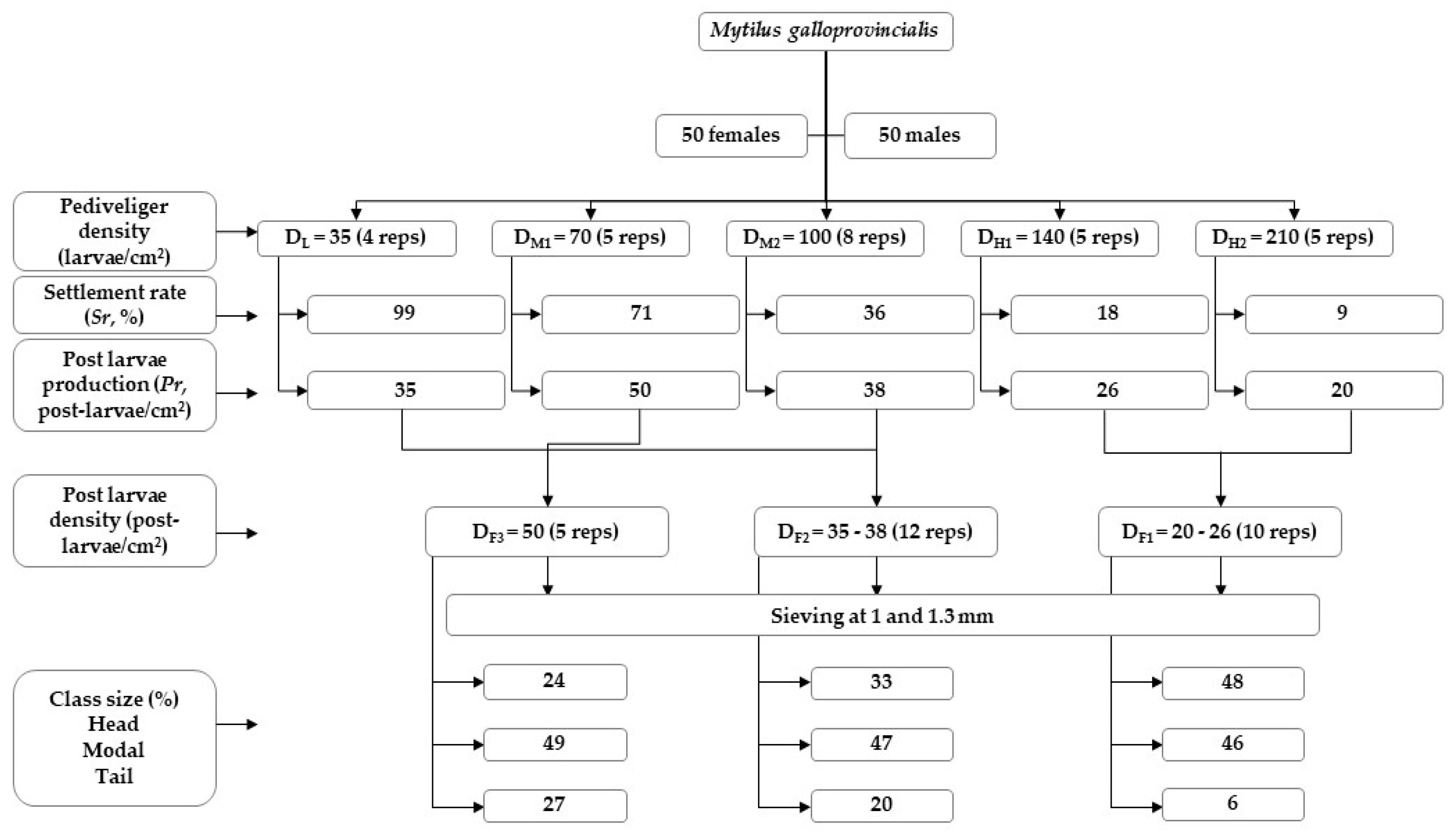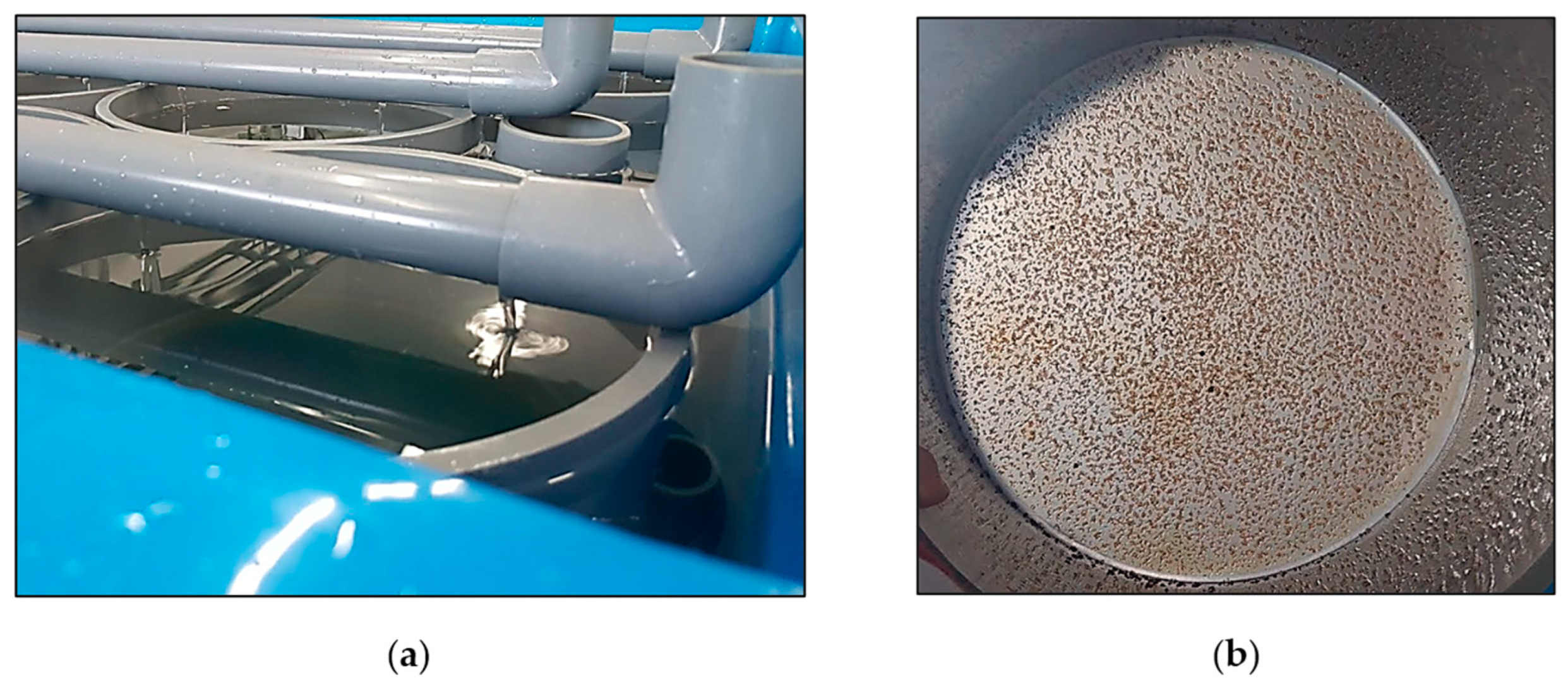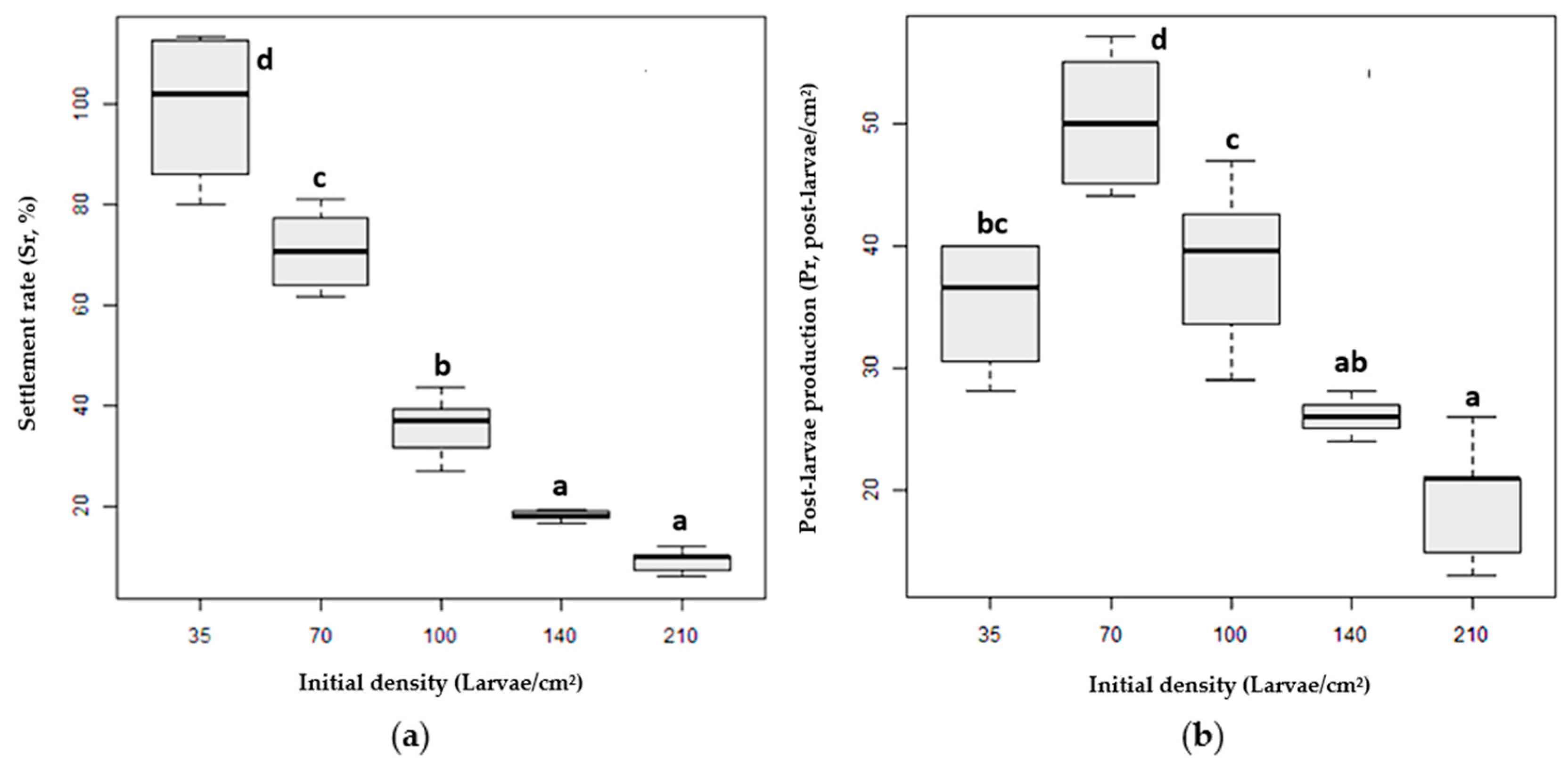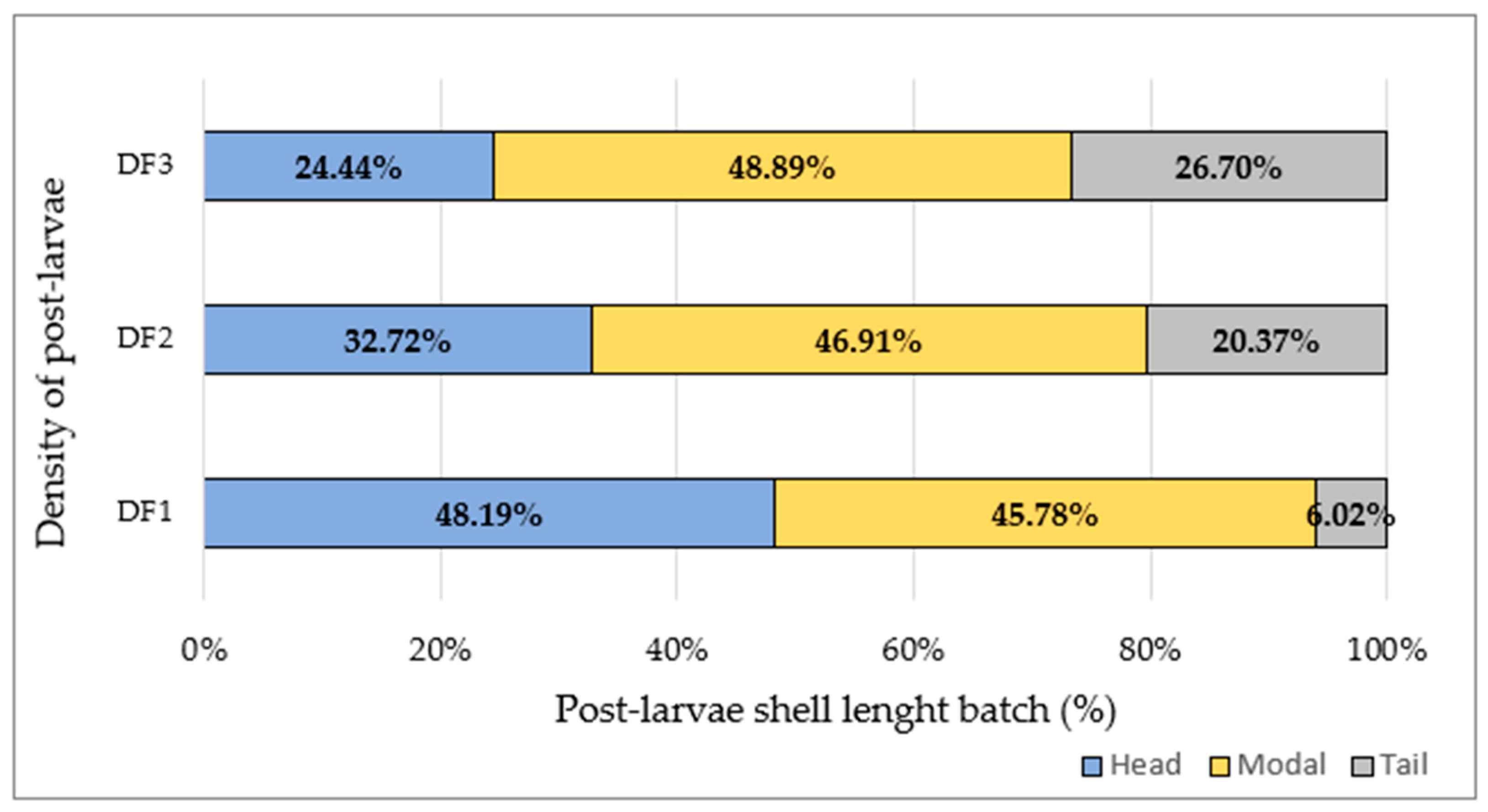Influence of Pediveliger Larvae Stocking Density on Settlement Efficiency and Seed Production in Captivity of Mytilus galloprovincialis in Amsa Bay, Tetouan
Abstract
Simple Summary
Abstract
1. Introduction
2. Materials and Methods
2.1. Spawning, Fertilization and Larval Rearing
2.2. Experimental Design
2.3. Statistical Analyses
3. Results
3.1. Effect of Density on Post-Larvae Settlement (Sr)
3.2. Effect of Density on Post-Larvae Production (Pr)
3.3. Effect of Stocking Density on Post-Larvae Shell Length Classes
3.4. Effect of Stocking Density on Post-Larvae Growth (Gr)
4. Discussion
5. Conclusions
Author Contributions
Funding
Institutional Review Board Statement
Informed Consent Statement
Data Availability Statement
Acknowledgments
Conflicts of Interest
References
- Smaal, A.C.; Ferreira, J.G.; Grant, J.; Petersen, J.K.; Strand, Ø. Provisioning of Mussel Seed and Its Efficient Use in Culture. In Goods and Services of Marine Bivalves, 1st ed.; Smaal, A.C., Ferreira, J.G., Grant, J., Petersen, J.K., Strand, Ø., Eds.; Springer: Cham, Switzerland, 2019; pp. 27–50. [Google Scholar] [CrossRef]
- Maynard, D.J.; Trial, J.G. The use of hatchery technology for the conservation of Pacific and Atlantic salmon. Rev. Fish Biol. Fish. 2014, 24, 803–817. [Google Scholar] [CrossRef]
- Naish, K.A.; Taylor, J.E.; Levin, P.S.; Quinn, T.P.; Winton, J.R.; Huppert, D.; Hilborn, R. An Evaluation of the Effects of Conservation and Fishery Enhancement Hatcheries on Wild Populations of Salmon. Adv. Mar. Biol. 2007, 53, 61–194. [Google Scholar] [CrossRef] [PubMed]
- Valin, H.; Sands, R.D.; Van der Mensbrugghe, D.; Nelson, G.C.; Ahammad, H.; Blanc, E.; Bodirsky, B.; Fujimori, S.; Hasegawa, T.; Havlik, P.; et al. The future of food demand: Understanding differences in global economic models. J. Agric. Econ. 2014, 45, 51–67. [Google Scholar] [CrossRef]
- Nascimento-Schulze, J.C.; Bean, T.P.; Houston, R.D.; Santos, E.M.; Sanders, M.B.; Lewis, C.; Ellis, R.P. Optimizing hatchery practices for genetic improvement of marine bivalves. Rev. Aquac. 2021, 13, 2289–2304. [Google Scholar] [CrossRef]
- Galley, T.H.; Batista, F.M.; Braithwaite, R.; King, J.; Beaumont, A.R. Optimisation of larval culture of the mussel Mytilus edulis (L.). Aquac. Int. 2010, 18, 315–325. [Google Scholar] [CrossRef]
- Figueras, A. Biología y Cultivo del Mejillón (Mytilus galloprovincialis) en Galicia; CSIC: Madrid, Spain, 2007; p. 282. ISBN 9788400085261. [Google Scholar]
- Rothschild, B.J.; Ault, J.S.; Goulletquer, P.; Héral, M. Decline of the Chesapeake Bay oyster population: A century of habitat destruction and overfishing. Mar. Ecol. Prog. Ser. 2023, 111, 29–39. [Google Scholar] [CrossRef]
- Ouagajjou, Y.; Aghzar, A.; Presa, P. Population Genetic Divergence among Worldwide Gene Pools of the Mediterranean Mussel Mytilus galloprovincialis. Animals 2023, 13, 3754. [Google Scholar] [CrossRef]
- Gosling, E. Genetics of Mytilus; Elsevier: Amsterdam, The Netherlands, 1992; pp. 309–382. [Google Scholar]
- Hilbish, T.J.; Mullinax, A.; Dolven, S.I.; Meyer, A.; Koehn, R.K.; Rawson, P.D. Origin of the antitropical distribution pattern in marine mussels (Mytilus spp.): Routes and timing of transequatorial migration. Mar. Biol. 2000, 136, 69–77. [Google Scholar] [CrossRef]
- Lichtfouse, E.; Schwarzbauer, J.; Robert, D. Environmental Chemistry for a Sustainable World: Remediation of Air and Water Pollution, 1st ed.; Springer: Dordrecht, The Netherlands, 2011; p. 541. [Google Scholar]
- Wonham, M.J. Mini-review: Distribution of the Mediterranean mussel, Mytilus galloprovincialis (Bivalvia: Mytilidae), and hybrids in the northeast Pacific. J. Shellfish Res. 2023, 23, 535–544. [Google Scholar] [CrossRef]
- Comesaña, A.S.; Posada, D.; Sanjuan, A. Mytilus galloprovincialis Lmk. in northern Africa. J. Exp. Mar. Biol. Ecol. 1998, 223, 271–283. [Google Scholar] [CrossRef]
- Jaziri, H.; Benazzou, T. Différenciation allozymique multilocus des populations de moule Mytilus galloprovincialis Lmk. des côtes marocaines. Comptes Rendus Biol. 2002, 325, 1175–1183. [Google Scholar] [CrossRef] [PubMed]
- Ouagajjou, Y.; Presa, P. The connectivity of Mytilus galloprovincialis in northern Morocco: A gene flow crossroads between continents. Estuar. Coast Shelf Sci. 2015, 152, 1–10. [Google Scholar] [CrossRef]
- Idhalla, M.; Nhhala, H.; Kassila, J.; Ait Chattou, E.M.; Orbi, A.; Moukrim, A. Comparative production of two mussel species (Perna perna and Mytilus galloprovincialis) reared on an offshore submerged longline system in Agadir, Morocco. Int. J. Sci. Eng. Res. 2017, 8, 1203–1213. [Google Scholar] [CrossRef]
- Ouagajjou, Y.; Aghzar, A.; Miñambres, M.; Presa, P.; Pérez, M. Differential gene flow between populations of Mytilus galloprovincialis distributed along Iberian and north African coasts. Thalassas 2010, 26, 75–78. [Google Scholar]
- Abada-Boudjema, Y.M.; Dauvin, J.C. Recruitment and life span of two natural mussel populations Perna perna (Linnaeus) and Mytilus galloprovincialis (Lamarck) from the Algerian coast. J. Molluscan Stud. 1995, 61, 467–481. [Google Scholar] [CrossRef]
- Maanan, M. Biomonitoring of heavy metals using Mytilus galloprovincialis in Safi coastal waters, Morocco. Environ. Toxicol. 2007, 22, 525–531. [Google Scholar] [CrossRef]
- Azizi, G.; Layachi, M.; Akodad, M.; Yáñez-Ruiz, D.R.; Martín-García, A.I.; Baghour, M.; Mesfioui, A.; Skalli, A.; Moumen, A. Seasonal variations of heavy metals content in mussels (Mytilus galloprovincialis) from Cala Iris offshore (Northern Morocco). Mar. Pollut. Bull. 2018, 137, 88–694. [Google Scholar] [CrossRef]
- Ben Haddouch, A.; Amanhi, R.; Amzil, Z.; Taleb, H.; Rovillon, G.A.; Adly, F.; Loutfi, M. Lipophilic Toxin Profile in Mytilus galloprovincialis from the North Atlantic Coast of Morocco: LC-MS/MS and Mouse Bioassay Analyses. Int. J. Sci. Res. 2017, 6, 186. [Google Scholar] [CrossRef]
- Kouali, H.; Chaouti, A.; Achtak, H.; Elkalay, K.; Dahbi, A. Trace metal contents in the mussel Mytilus galloprovincialis from Atlantic coastal areas in northwestern Morocco: Levels of contamination and assessment of potential risks to human health. Mar. Pollut. Bull. 2022, 179, 113680. [Google Scholar] [CrossRef]
- Aghzar, A.; Talbaoui, M.; Benajiba, M.H.; Presa, P. Influence of depth and diameter of rope collectors on settlement density of Mytilus galloprovincialis spat in Baie de M’diq (Alboran Sea). Mar Freshw. Behav. Physiol. 2012, 45, 51–61. [Google Scholar] [CrossRef]
- Ait Chattou, E.M.; Abounahel, N.; Kassila, J.; Ouagajjou, Y.; Abouhala, A.; Idhalla, M.; Moukrim, A. Differential growth of the brown mussel, Perna perna (Linnaeus, 1758), in longline and pole cultures in Dakhla Bay (SW Morocco, Atlantic Ocean). Aquac. Res. 2019, 50, 736–747. [Google Scholar] [CrossRef]
- Fearman, J.A.; Bolch, C.J.; Moltschaniwskyj, N.A. Energy Storage and Reproduction in Mussels, Mytilus galloprovincialis: The Influence of Diet Quality. J. Shellfish Res. 2009, 28, 305–312. [Google Scholar] [CrossRef]
- Drissou, H.; Ouagajjou, Y.; Aghzar, A. Ecophysiology of the Mediterranean mussel Mytilus galloprovincialis L; effect of different microalgae diets and ration on broodstock conditioning. In Proceedings of the 1st International Congress on Coastal Research, Al Hoceima, Morocco, 6–9 July 2021. [Google Scholar] [CrossRef]
- Aghzar, A.; Talbaoui, M.; Benajiba, M.H.; Presa, P. Small-fast growers of Mytilus galloprovincialis do not catch up: An experimental test with size-graded mussels cultured in longline suspended bags. Mar. Freshw. Behav. Physiol. 2012, 45, 223–234. [Google Scholar] [CrossRef]
- Martínez-Pita, I.; Sánchez-Lazo, C.; Herrera, M. A non-lethal method for establishing sexual maturation in mussels (Mytilus galloprovincialis (Lamarck, 1819)) during broodstock conditioning in hatcheries. Aquac. Int. 2016, 24, 1247–1254. [Google Scholar] [CrossRef]
- Díaz-Puente, B.; Miñambres, M.; Rosón, G.; Aghzar, A.; Presa, P. Genetic decoupling of spat origin from hatchery to harvest of Mytilus galloprovincialis cultured in suspension. Aquaculture 2016, 460, 124–135. [Google Scholar] [CrossRef]
- Pronker, A.E.; Nevejan, N.M.; Peene, F.; Geijsen, P.; Sorgeloos, P. Hatchery broodstock conditioning of the blue mussel Mytilus edulis (Linnaeus 1758). Part I. Impact of different micro-algae mixtures on broodstock performance. Aquacult. Int. 2008, 16, 297–307. [Google Scholar] [CrossRef]
- Kamermans, P.; Galley, T.; Boudry, P.; Fuentes, J.; McCombie, H.; Batista, F.M.; Blanco, A.; Dominguez, L.; Cornette, F.; Pincot, L.; et al. Blue mussel hatchery technology in Europe. In Advances in Aquaculture Hatchery Technology, 1st ed.; Allan, G., Burnell, G., Eds.; Woodhead Publishing: Sawston, UK, 2013; pp. 339–373. [Google Scholar] [CrossRef]
- Aghzar, A.; Miñambres, M.; Alvarez, P.; Presa, P. A cost-benefit assessment of two multi-species algae diets for juveniles of Mytilus galloprovincialis. Int. J. Mar. Sci. 2013, 29, 9–16. [Google Scholar]
- Martínez-Pita, I.; Sánchez-Lazo, C.; Ruíz-Jarabo, I.; Herrera, M.; Mancera, J.M. Biochemical composition, lipid classes, fatty acids, and sexual hormones in the mussel Mytilus galloprovincialis from cultivated populations in south Spain. Aquaculture 2012, 358–359, 274–283. [Google Scholar] [CrossRef]
- El Moussaoui, M.A.; Ouagajjou, Y.; Aghzar, A.; Saoud, Y.; Nhhala, H. Feeding and growth coupling during different development larvae phases of the Mediterranean mussel Mytilus galloprovincialis L. from Amsa Bay. In Proceedings of the 1st International Congress on Coastal Research, Al Hoceima, Morocco, 6–9 July 2021. [Google Scholar] [CrossRef]
- Sánchez-Lazo, C.; Martínez-Pita, I. Effects of different mono, bi and trispecific microalgal diets on survival, growth, development, settlement, and fatty acid composition of mussel Mytilus galloprovincialis (Lamarck, 1819) larvae. Aquaculture 2014, 426–427, 138–147. [Google Scholar] [CrossRef]
- Pettersen, A.K.; Turchini, G.M.; Jahangard, S.; Ingram, B.A.; Sherman, C.D. Effects of different dietary microalgae on survival, growth, settlement, and fatty acid composition of blue mussel (Mytilus galloprovincialis) larvae. Aquaculture 2010, 309, 115–124. [Google Scholar] [CrossRef]
- Bordignon, F.; Trocino, A.; Rossetti, E.; Zomeno, C.; Pascual, A.; Birolo, M.; Martinez-Llorens, S.; Xiccato, G. Effect of stocking density on growth and survival of juvenile Manila clams (Ruditapes philippinarum) farmed in suspended lanterns in a North Italian lagoon. Aquac. Rep. 2021, 20, 100719. [Google Scholar] [CrossRef]
- Liu, Y.; Catalano, S.R.; Qin, J.; Han, J.; Zhan, X.; Li, X. Effects of cryopreservation on redox status and gene expression of trochophore larvae in Mytilus galloprovincialis. J. World. Aquac. Soc. 2022, 53, 516–526. [Google Scholar] [CrossRef]
- Anguiano-Beltrán, C.; Lizárraga-Partida, M.L.; Searcy-Bernal, R. Effect of Vibrio alginolyticus on larval survival of the blue mussel Mytilus galloprovincialis. Dis. Aquat. Organ. 2004, 59, 119–123. [Google Scholar] [CrossRef] [PubMed]
- Kurihara, H.; Asai, T.; Kato, S.; Ishimatsu, A. Effects of elevated pCO2 on early development in the mussel Mytilus galloprovincialis. Aquat. Biol. 2008, 4, 225–233. [Google Scholar] [CrossRef]
- Joyce, A.; Vogeler, S. Molluscan bivalve settlement and metamorphosis: Neuroendocrine inducers and morphogenetic responses. Aquaculture 2018, 487, 64–82. [Google Scholar] [CrossRef]
- Satuito, C.G.; Natoyama, K.; Yamazaki, M.; Fusetani, N. Inductin of Attachment and Metamorphosis of Laboratory Cultures Mussel Mytilus edulis galloprovincialis Larvae by Microbial Film. Fish. Sci. Res. 1995, 61, 223–227. [Google Scholar] [CrossRef]
- Tamburri, M.N.; Zimmer-Faust, R.K.; Tamplin, M.L. Natural Sources and Properties of Chemical Inducers Mediating Settlement of Oyster Larvae: A Re-examination. Biol. Bull. 1992, 183, 327–338. [Google Scholar] [CrossRef]
- Nevejan, N.; Davis, J.; Little, K.; Kiliona, A. Use of a formulated diet for mussel spat Mytilus galloprovincialis (Lamarck 1819) in a commercial hatchery. J. Shellfish Res. 2007, 26, 357–363. [Google Scholar] [CrossRef]
- Yang, J.L.; Satuito, C.G.; Bao, W.Y.; Kitamura, H. Larval settlement, and metamorphosis of the mussel Mytilus galloprovincialis on different macroalgae. Mar. Biol. 2007, 152, 1121–1132. [Google Scholar] [CrossRef]
- Crisp, D.J. Factors influencing the settlement of marine invertebrate larvae. In Chemoreception in Marine Organisms; Academic Press: London, UK, 1974. [Google Scholar]
- Mazón-Suástegui, J.M.; Ruíz-Ruíz, K.M.; Parres-Haro, A.; Saucedo, P.E. Combined effects of diet and stocking density on growth and biochemical composition of spat of the Cortez oyster Crassostrea corteziensis at the hatchery. Aquaculture 2008, 284, 98–105. [Google Scholar] [CrossRef]
- Roland, W.G.; Albrecht, K.J. Production of Pacific oysters, Crassostrea gigas Thunberg, from wild-caught and hatchery-produced seed grown at several densities on oyster shells. Aquac. Res. 1990, 21, 31–38. [Google Scholar] [CrossRef]
- Taylor, J.J.; Rose, R.A.; Southgate, P.C.; Taylor, C.E. Effects of stocking density on growth and survival of early juvenile silver-lip pearl oysters, Pinctada maxima (Jameson), held in suspended nursery culture. Aquaculture 1997, 153, 41–49. [Google Scholar] [CrossRef]
- Liu, B.; Dong, B.; Tang, B.; Zhang, T.; Xiang, J. Effect of stocking density on growth, settlement, and survival of clam larvae, Meretrix meretrix. Aquaculture 2006, 258, 344–349. [Google Scholar] [CrossRef]
- Karayücel, S.; Çelik, M.Y.; Karayücel, İ.; Öztürk, R.; Eyüboğlu, B. Effects of stocking density on survival, growth, and biochemical composition of cultured mussels (Mytilus galloprovincialis, Lamarck 1819) from an offshore submerged longline system. Aquac. Res. 2015, 46, 1369–1383. [Google Scholar] [CrossRef]
- Bacalhau de Oliveira, I.; Lavander, H.D.; Lima, P.; Barbosa de Oliveira, C.Y.; Macedo Dantas, D.M.; Olivera-Gálvez, A. Effect of stocking density on the growth and survival of Anomalocardia brasiliana (Gmelin, 1791) (Bivalvia: Veneridae) post-larvae. Ciência Rural 2019, 49, e20190420. [Google Scholar] [CrossRef]
- Lagos, L.; Herrera, M.; Sánchez-Lazo, C.; Martínez-Pita, I. Effect of larval stocking density on growth, survival, and whole body cortisol of the Mediterranean mussel Mytilus galloprovincialis (Lamarck, 1819) larvae reared under laboratory conditions. Aquac. Res. 2015, 46, 1648–1656. [Google Scholar] [CrossRef]
- Welch, B.L. The generalization of ‘STUDENT’S’ problem when several different population variances are involved. Biometrika 1947, 34, 28–35. [Google Scholar] [CrossRef] [PubMed]
- RStudio. Integrated Development for R. RStudio, Inc., Boston, MA, USA (Computer Software v0.98.1074). Available online: http://www.rstudio.com/ (accessed on 14 February 2022).
- Kamermans, P.; Blanco, A.; Joaquim, S.; Matias, D.; Magnesen, T.; Nicolas, J.L.; Petten, B.; Robert, R. Recirculation nursery systems for bivalves. Aquac. Int. 2016, 24, 827–842. [Google Scholar] [CrossRef]
- De Pauw, N. Use and production of microalgae as food for nursery bivalves. In Nursery Culturing of Bivalve Molluscs: Proceedings of the International Workshop on Nursery Culturing of Bivalve Molluscs Ghent, Belgium, 24–26 February 1981; Special Publication European Mariculture Society: Bredene, Belgium, 1981; Volume 7, pp. 35–69. [Google Scholar]
- Rodhouse, P.G.; O’kelly, M. Flow requirements of the oysters Ostrea edulis L. and Crassostrea gigas Thunb. in an upwelling column system of culture. Aquaculture 1981, 22, 1–10. [Google Scholar] [CrossRef]
- Laing, I.; Millican, P.F. Indoor nursery cultivation of juvenile bivalve molluscs using diets of dried algae. Aquaculture 1992, 102, 231–243. [Google Scholar] [CrossRef]
- Sanjayasari, D.; Jeffs, A. Optimising environmental conditions for nursery culture of juvenile GreenshellTM mussels (Perna canaliculus). Aquaculture 2019, 512, 734338. [Google Scholar] [CrossRef]
- Coleman, S.; Morse, D.; Brayden, W.C.; Brady, D.C. Developing a bioeconomic framework for scallop culture optimization and product development. Aquac. Econ. Manag. 2023, 27, 25–49. [Google Scholar] [CrossRef]
- Turini, C.S.; Sühnel, S.; Lagreze-Squella, F.J.; Ferreira, J.F.; Melo, C.M.R.D. Effects of stocking-density in flow-through system on the mussel Perna perna larval survival. Acta Sci. 2014, 36, 247–252. [Google Scholar] [CrossRef][Green Version]
- Zhang, M.; Gao, X.; Lyu, M.; Lin, S.; Luo, X.; You, W.; Ke, C. Effect of stocking density on the growth and settlement of Haliotis discus hannai larvae in a recirculating aquaculture system. Aquac. Res. 2022, 53, 1468–1480. [Google Scholar] [CrossRef]
- Kobak, J. Light, gravity, and conspecifics as cues to site selection and attachment behaviour of juvenile and adult Dreissena polymorpha Pallas, 1771. J. Molluscan Stud. 2001, 67, 183–189. [Google Scholar] [CrossRef]
- Toonen, R.J.; Pawlik, J.R. Foundations of gregariousness. Nature 1994, 370, 511–512. [Google Scholar] [CrossRef]
- Alagarswami, K.; Dharmaraj, S.; Chellam, A.; Velayudhan, T.S. Larval and juvenile rearing of black-lip pearl oyster, Pinctada margaritifera (Linnaeus). Aquaculture 1989, 76, 43–56. [Google Scholar] [CrossRef]
- García-Lavandeira, M.; Silva, A.; Abad, M.; Pazos, A.J.; Sánchez, J.L.; Pérez-Parallé, M.L. Effects of GABA and epinephrine on the settlement and metamorphosis of the larvae of four species of bivalve molluscs. J. Exp. Mar. Biol. Ecol. 2005, 316, 149–156. [Google Scholar] [CrossRef]
- Crimaldi, J.P.; Thompson, J.K.; Rosman, J.H.; Lowe, R.J.; Koseff, J.R. Hydrodynamics of larval settlement: The influence of turbulent stress events at potential recruitment sites. Limnol. Oceanogr. 2002, 47, 1137–1151. [Google Scholar] [CrossRef]
- Manoj Nair, R.; Appukuttan, K.K. Effect of temperature on the development, growth, survival, and settlement of green mussel Perna viridis (Linnaeus, 1758). Aquac. Res. 2003, 34, 1037–1045. [Google Scholar] [CrossRef]
- Laxmilatha, P.; Rao, G.S.; Patnaik, P.; Rao, T.N.; Rao, M.P.; Dash, B. Potential for the hatchery production of spat of the green mussel Perna viridis Linnaeus (1758). Aquaculture 2011, 312, 88–94. [Google Scholar] [CrossRef]
- Weston, K.; Jahangard, S.; Ingram, B.A.; Miller, A.D.; Jennings, G.; Sherman, C.D. Factors affecting settlement, growth, and metamorphosis of hatchery-produced Australian blue mussel larvae. Aquacult. Int. 2021, 29, 1963–1977. [Google Scholar] [CrossRef]
- Dégremont, L.; Bédier, E.; Soletchnik, P.; Ropert, M.; Huvet, A.; Moal, J.; Samain, J.F.; Boudry, P. Relative importance of family, site, and field placement timing on survival, growth, and yield of hatchery-produced Pacific oyster spat (Crassostrea gigas). Aquaculture 2005, 249, 213–229. [Google Scholar] [CrossRef]
- Schram, E.; Van der Heul, J.W.; Kamstra, A.; Verdegem, M.C.J. Stocking density-dependent growth of Dover sole (Solea solea). Aquaculture 2006, 252, 339–347. [Google Scholar] [CrossRef]
- Canario, A.V.; Condeca, J.; Power, D.M.; Ingleton, P.M. The effect of stocking density on growth in the gilthead seabream, Sparus aurata (L.). Aquac. Res. 1998, 29, 177–181. [Google Scholar] [CrossRef]
- Alfaro, A.C. Effect of water flow and oxygen concentration on early settlement of the New Zealand green-lipped mussel, Perna canaliculus. Aquaculture 2005, 246, 285–294. [Google Scholar] [CrossRef]
- Oliva, D.; Abarca, A.; Gutiérrez, R.; Celis, Á.; Herrera, L.; Pizarro, V. Effect of stocking density and diet on growth and survival of post-larvae of the taquilla clam Mulinia edulis cultivated in sand in a hatchery. Rev. Biol. Mar. Oceanogr. 2013, 48, 37–44. [Google Scholar] [CrossRef]
- Santos, F.A.; Boaventura, T.P.; da Costa Julio, G.S.; Cortezzi, P.P.; Figueiredo, L.G.; Favero, G.; Palheta, G.; Melo, N.; Luz, R.K. Growth performance and physiological parameters of Colossoma macropomum in a recirculating aquaculture system (RAS): Importance of stocking density and classification. Aquaculture 2021, 534, 736274. [Google Scholar] [CrossRef]
- Gervis, M.H.; Sims, N.A. The Biology and Culture of Pearl Oysters (Bivalvia pteriidae); Overseas Development Administration and International Center for Living Aquatic Resources Management: London, UK; Manila, Philippines, 1992; p. 49. [Google Scholar]
- Magnuson, J.J. An analysis of aggressive behavior, growth, and competition for food and space in medaka (Oryzias latipes (Pisces, Cyprinodontidae)). Can. J. Zool. 2011, 40, 313–363. [Google Scholar] [CrossRef]
- Wilson, J. Hatchery rearing of Ostrea edulis and Crassostrea gigas. Aquac. Tech. Bull. 1981, 4, 1–34. [Google Scholar]
- Roncarati, A.; Felici, A.; Magi, G.E.; Bilandžić, N.; Melotti, P. Growth and survival of cupped oysters (Crassostrea gigas) during nursery and pregrowing stages in open sea facilities using different stocking densities. Aquac. Int. 2017, 25, 1777–1785. [Google Scholar] [CrossRef]
- Gui, Y.; Kaspar, H.F.; Zamora, L.N.; Dunphy, B.J.; Jeffs, A.G. Capture efficiency of artificial food particles of post-settlement juveniles of the Greenshell™ mussel, Perna canaliculus. Aquaculture 2016, 464, 1–7. [Google Scholar] [CrossRef]





| Initial Density (Larvae/cm2) | Mean Sr (±SD) 1 | df_num | df_den | F | p-Value |
|---|---|---|---|---|---|
| DL | 0.99 ± 0.16 d | 4.00 | 8.90 | 93.45 | 2.859 × 10−7 *** |
| DM1 | 0.71 ± 0.08 c | ||||
| DM2 | 0.36 ± 0.05 b | ||||
| DH1 | 0.18 ± 0.01 a | ||||
| DH2 | 0.09 ± 0.02 a |
| Initial Density (Larvae/cm2) | Post-Larvae Production (Mean Pr ± SD) 1 | df_num | df_den | F | p-Value |
|---|---|---|---|---|---|
| DL | 35.25 ± 5.85 b | 4 | 9.08 | 25.73 | 5.718 × 10−5 *** |
| DM1 | 50.20 ± 5.80 a | ||||
| DM2 | 38.35 ± 5.93 b 26.00 ± 1.58 c | ||||
| DH1 | 26.00 ± 1.58 c | ||||
| DH2 | 19.20 ± 5.21 c |
| Density (Post-Larvae/cm2) | Growth Rate (Mean Gr ± SD) 1 | df_num | df_den | F | p-Value |
|---|---|---|---|---|---|
| DF1 | 22.24 ± 4.60 a | 2 | 16.68 | 1.576 × 10−7 *** | |
| DF2 | 20.73 ± 4.65 b | 250.97 | |||
| DF3 | 19.23 ± 3.75 c |
| Batch | Density Group | Growth (Gr ± SD) 1 | df_num | df_den | F | p-Value |
|---|---|---|---|---|---|---|
| Tail | DF1 | 12.76 ± 3.14 a | 2 | 20.06 | 6.72 | 2.25 × 10−3 ** |
| DF2 | 14.68 ± 0.84 b | |||||
| DF3 | 14.58 ± 1.14 b | |||||
| Modal | DF1 | 19.27 ± 1.66 a | 2 | 105.85 | 0.20 | 0.82 ns |
| DF2 | 19.45 ± 1.86 a | |||||
| DF3 | 19.38 ± 2.08 a | |||||
| Head | DF1 | 26.40 ± 2.55 b | 2 | 89.42 | 31.66 | 4.02 × 10−11 *** |
| DF2 | 26.24 ± 2.19 b | |||||
| DF3 | 23.99 ± 0.97 a |
Disclaimer/Publisher’s Note: The statements, opinions and data contained in all publications are solely those of the individual author(s) and contributor(s) and not of MDPI and/or the editor(s). MDPI and/or the editor(s) disclaim responsibility for any injury to people or property resulting from any ideas, methods, instructions or products referred to in the content. |
© 2024 by the authors. Licensee MDPI, Basel, Switzerland. This article is an open access article distributed under the terms and conditions of the Creative Commons Attribution (CC BY) license (https://creativecommons.org/licenses/by/4.0/).
Share and Cite
Janah, H.; Aghzar, A.; Presa, P.; Ouagajjou, Y. Influence of Pediveliger Larvae Stocking Density on Settlement Efficiency and Seed Production in Captivity of Mytilus galloprovincialis in Amsa Bay, Tetouan. Animals 2024, 14, 239. https://doi.org/10.3390/ani14020239
Janah H, Aghzar A, Presa P, Ouagajjou Y. Influence of Pediveliger Larvae Stocking Density on Settlement Efficiency and Seed Production in Captivity of Mytilus galloprovincialis in Amsa Bay, Tetouan. Animals. 2024; 14(2):239. https://doi.org/10.3390/ani14020239
Chicago/Turabian StyleJanah, Hafsa, Adil Aghzar, Pablo Presa, and Yassine Ouagajjou. 2024. "Influence of Pediveliger Larvae Stocking Density on Settlement Efficiency and Seed Production in Captivity of Mytilus galloprovincialis in Amsa Bay, Tetouan" Animals 14, no. 2: 239. https://doi.org/10.3390/ani14020239
APA StyleJanah, H., Aghzar, A., Presa, P., & Ouagajjou, Y. (2024). Influence of Pediveliger Larvae Stocking Density on Settlement Efficiency and Seed Production in Captivity of Mytilus galloprovincialis in Amsa Bay, Tetouan. Animals, 14(2), 239. https://doi.org/10.3390/ani14020239








